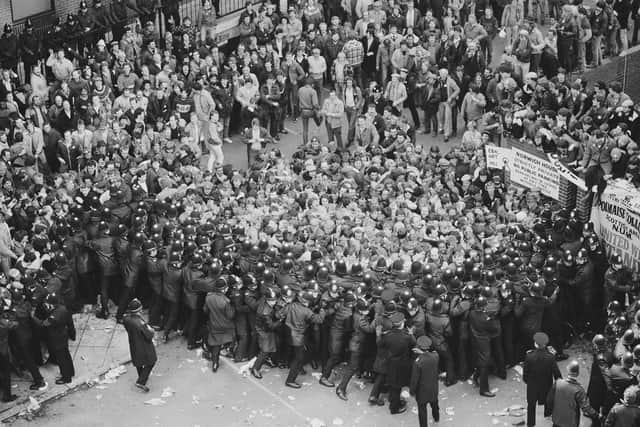Worst power cuts in UK history from miners’ strike under Margaret Thatcher government to the London blackout in 2003
Following the news from National Grid that Britain could face three-hour daily blackouts this winter, we have taken a look at some of the worst power cuts in UK history.
The miners’ strike - 1984-1985
This was a major industrial action within the British coal industry at the time of Margaret Thatcher’s leadership in an attempt to protest against colliery closures.
Advertisement
Hide AdAdvertisement
Hide Ad

The strike was led by Arthur Scargill of the National Union of Mineworkers (NUM) against the National Coal Board (NCB), an agency of the government.
The Conservative government of Prime Minister Margaret Thatcher wanted to reduce the power of the trade unions.
The strike started on March 6, 1984 and ended on March 3, 1985 and it resulted in power cuts across the country; the number of people who lost working days due to the strike was more than 26 million - which made it the largest strike since the 1926 general strike.
Poverty increased in former coal mining areas and in 1994 Grimethorpe in South Yorkshire was named the poorest area in the country.
The Great Storm of 1987
Advertisement
Hide AdAdvertisement
Hide AdThe strong winds of up to 100mph created havoc across the country; 18 people were killed, 15 million trees were blown down and fell on roads and railways, resulting in major transport delays.
Others took down electricity and telephone lines, causing major power outages for thousands of people which lasted for more than 24 hours.
London Blackout of 2003
The major power cut occurred in parts of southern London and north-west Kent on August 28, 2003 and was the largest blackout in South East England since the Great Storm of 1987.
It affected roughly 500,000 people. It is thought to have lasted two hours and the London Fire Brigade were called by 400 residents and made 100 rescues of people who were stuck in lifts.
UK floods in 2007
Advertisement
Hide AdAdvertisement
Hide AdThe UK was devastated by large floods across the country during the summer of 2007, with the worst flood occurring across Scotland on June 14.
Some of the major floods also impacted East Yorkshire and the Midlands on June 15, Yorkshire, the Midlands, Gloucestershire, Herefordshire and Worcestershire on June 25 and Gloucestershire, Herefordshire, Worcestershire, Oxfordshire, Berkshire and South Wales on July 28.
June of that year was one of the wettest months on record in Britain and it was Britain’s wettest May-July period since 1776.
On Monday, June 25, 2007, more than 10,000 Britons were affected by power outages in northern England and around 35,000 homes and businesses had power cuts after the Neepsend substation in Sheffield was flooded.
UK floods of 2013-2014
Advertisement
Hide AdAdvertisement
Hide AdThese winter floods occurred from December 5, 2013 to February 25, 2014 and heavily impacted areas of Ireland and the UK following severe storms.
The south of England saw heavy rainfall associated with the storms which caused widespread flooding, power outages and major disruptions to transport.
The worst areas affected economically were Somerset, Devon, Dorset and Cornwall in the south west and the Thames Valley in the south east.
Autumn storm in October 2013
A severe autumnal storm brought devastation across much of southern England on October 28, 2013.
Advertisement
Hide AdAdvertisement
Hide AdAccording to the Met Office, the storm occurred due to a fast-moving, vigorous Atlantic depression, bringing both very strong winds and heavy rain.
The speed of the winds were 58 to 69mph and the highest on record was 99mph at Needles Old Battery, Isle of Wight.
Most of the damage resulted in falling trees and was considered within the top 10 most severe autumn storms to affect southern England in the last 40 years at the time.
Four people died in Kent, Watford and west London and there was severe disruption to transport networks with train services for commuters suspended, reduced flights, disruption on roads and many ferry services were cancelled.
Advertisement
Hide AdAdvertisement
Hide AdMore than 600,000 homes were affected by power cuts as tree branches brought down power lines.
Winter storms - December 2013 to January 2014
From mid-December to early January, the UK suffered from a period of extreme weather, as strong storms spread across the country.
The storm of December 5 saw Scotland’s rail network shut down, 100,000 homes were left without power, flight cancellations at Glasgow, Edinburgh and Aberdeen, fallen trees, traffic accidents and two fatalities.
Overall the December and January storms caused around seven deaths and 1,700 properties flooded across England.
Britain and Ireland floods - 2015 to 2016
Advertisement
Hide AdAdvertisement
Hide AdThe series of floods resulted in around 3,000 homes impacted by power cuts in North and West Yorkshire on December 26, 2015 and most of the power outages occurred in the Calder Valley and around Bingley and Skipton.
Many parts of Mirfield were flooded and affected local businesses; The Ship Inn, Mill Carpets and Furniture and Choice who lost 10 per cent of their stock to flood damage.
In Leeds the River Aire flooded over its bank causing flooding in the Kirkstall Road area of the city, which blocked a main route into the city.
A total of 7,574 homes across the north of England were without power by 8am on December 27 and around 5,500 of these homes without power were located in the town of Rochdale in Greater Manchester.
Comment Guidelines
National World encourages reader discussion on our stories. User feedback, insights and back-and-forth exchanges add a rich layer of context to reporting. Please review our Community Guidelines before commenting.
